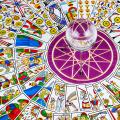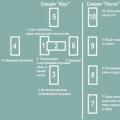“Groups of road signs” - Additional information signs. Service signs. Motorway. Intersection with a bicycle path. Purpose. Railway crossing with barrier. No entry. The order of passage of intersections. Priority signs. Living sector. Road signs. Warning signs. Riding bicycles. Rectangle.
“Road sign system” - Road signs and other traffic signs. Proposals for the development of the information system. Payback period. Average accident statistics. Example of image placement. Type of special shields. The main content of the work. Economic damage. Current state of the route guidance system. Traffic safety measures.
“Traffic signs with explanations” - Entry prohibited. Hospital. Traffic rules for schoolchildren. Traffic rules for cyclists. Two-way traffic. No parking. Bicycles are prohibited. Follow traffic rules. Overtaking is prohibited. Truck traffic is prohibited. Resting-place.
“The history of road signs” - Modern signs. International convention regarding the movement of motor vehicles. Milestones. Which group do road signs belong to? The development of transport and the specifics of road traffic put forward new requirements. The first road signs appeared with the emergence of roads. Groups of road signs.
“Road signs” - From the history of traffic rules. Traffic lights and road signs. Layouts of traffic lights and cars. Mandatory signs. Information or clarification. Warning signs. What are the signs? Prohibition signs. Dramatization of a poem. The city is full of traffic. Poem. Information and directional signs.
“Rules of road signs” - The third wheel. Mandatory signs. Road equipment element. The lower edge of the span. Story. Warning signs. Road horizontal and vertical markings. Service signs. Horizontal marking. Vertical markings. Additional information signs. See you on the roads. Priority signs.
There are 12 presentations in total
Topic: History of road signs.The purpose of the lesson : introduce the history of road signs, the reasons for their complexity, and the international language of signs; teach to read road signs.
Equipment : traffic rules brochures, posters with road signs.
During the classes:
Org. moment.
Testing students' knowledge.
Why are road signs needed?
Where and how are road signs installed?
When do you think the first road signs appeared?
History of road signs.
Our Slavic ancestors also took care of travelers and tried to help them choose the right direction of travel. In wooded areas along the roads, they installed poles from tree branches, made notches on the trunks, and in the steppe along the roads they laid stones or put up pillars. Stone or wooden crosses were installed at road intersections and chapels were built.
More than 300 years ago, under Tsar Alexei Mikhailovich, milestones began to be installed for the first time. He ordered high pillars to be erected between Moscow and his country residence, the village of Kolomenskoye, at every verst, which were popularly nicknamed “Kolomenskoe versts.” At the same time, a saying arose about tall people: “Tall as the Kolomna mile.” Under Peter I, road construction in Russia increased sharply. On large roads (high roads) they began to install mileposts and paint them with stripes in the colors of the Russian national flag. The “striped miles” were clearly visible.
Later they began to install poles at intersections and put inscriptions on them explaining where each road leads. They placed pillars on the borders of counties, and inscriptions were made on them with the names of the counties. Between villages, small posts were also installed with signs indicating which village should be responsible for the condition of a particular section of the road. On dangerous sections of the road, gouges were installed. The roads on which the pillars were placed were called pillar roads; there were no pillars on the secondary roads.
But when a continuous stream of cars began to move along the roads instead of sleighs, carriages and carts drawn by horses, it turned out that distance indicators alone were not enough. It became clear that driving quickly and without accidents is only possible if the driver is helped by other road signs.
At first, each country had its own signs, and road authorities made them, each in its own way. When international road connections were poorly developed and drivers from one country rarely traveled to another, this situation could still be tolerated. But when road communications between countries became more developed, the need arose to introduce international road signs.
An attempt to introduce uniform international signs was made back in 1909. To this end, the International Conference on Road Signs met in Paris, at which four international signs were adopted.
These round-shaped signs had symbols that were almost identical to those used on modern signs to indicate the same types of hazards.
In 1968, at the next conference, 126 characters were already introduced. In 1978, a new GOST was adopted, which established 7 groups of road signs
Road signs are assigned numbers consisting of numbers. The first number is the number of the group to which the sign belongs; the second is the serial number of the sign in the group. For signs that have the same semantic meaning, a common serial number is retained, and the varieties of these signs are indicated by numbers separated by dots.
Warning signs.
What is the shape of the signs, their color, general meaning? What signs inform about the intersection of roads (with a tram line, with an equivalent road, with a roundabout)?
What signs warn of changes in road direction? (“Dangerous Turn”, “Dangerous Turns”).
What signs warn about road conditions? ("Slippery Road", "Rough Road", "Gravel Burst").
What signs warn of people and other obstacles on the road? (Road repairs, going to the embankment, approaching the drawbridge, 1.20 “Pedestrian crossing”, “Children”).
Priority signs.
How are roads divided according to their significance? (Major and secondary). What is the general meaning of priority signs? They establish the order of passage of intersections where someone must give way.
Do the signs in this group establish the order of travel only at intersections? Also the order of passage of narrow sections of roads.
There is a single octagonal sign in this group; which one and what is its meaning? Prohibition signs.
What is the shape of the signs, their color, general meaning? Give examples of prohibition signs.
Are all the signs in this group prohibiting traffic? There are signs prohibiting overtaking, parking, stopping, limiting the maximum speed, as well as signs. informing about the end of any restrictions).
Mandatory signs.
What is the shape of the signs, their color, general meaning? What signs allow traffic only in certain directions? Which signs allow driving only at a certain speed? Which signs allow only certain road users to move?
Information and directional signs.
What is their shape, color, general meaning? Give examples of signs and tell what they “say”. Which signs in this group are signs for pedestrians?
Service signs.
What are these signs and why are they needed? Give examples. Additional information signs. What is another name for these signs? (Plates). What is their significance? Can these signs be used independently? Only together with other signs. What signs of this group can be combined by type of vehicle? Which signs of this group can be combined by duration of action?
Consolidation. Testing “How do I know road signs”
History of road signs Completed by: Rakina Y. Kryukova I. Petrenko K. Barmicheva L. Road sign A road sign is a technical means of road safety, a standardized graphic design installed near the road to convey certain information to road users. The first road signs appeared almost simultaneously with the emergence of roads. To mark the route, primitive travelers broke branches and made marks on the bark of trees, and placed stones of a certain shape along the roads. The next step was to give the roadside structures a specific shape to make them stand out from the surrounding landscape. For this purpose, sculptures began to be placed along the roads. One of these sculptures - a Polovtsian woman - can be seen in the Kolomenskoye Museum-Reserve. After the emergence of writing, inscriptions began to be made on stones, usually writing the name of the settlement to which the road leads. The world's first system of road signs arose in Ancient Rome in the 3rd century. BC. Along the most important roads, the Romans placed cylindrical mile posts with the distance from the Roman Forum carved on them. Near the Temple of Saturn in the center of Rome there was a Golden Mile Pillar, from which all roads leading to all ends of the vast empire were measured. This system later became widespread in many countries. Russia was no exception - in the 16th century. On the instructions of Tsar Fyodor Ivanovich, mileposts about 4 m high with eagles on top were installed on the road leading from Moscow to the royal estate of Kolomenskoye. The appearance of the first self-propelled carriages on the roads required fundamental changes in the organization of road traffic. No matter how imperfect the first cars were, they moved much faster than horse-drawn carriages. The driver of the car had to react faster to the emerging danger than the coachman. It is also necessary to take into account that the horse, although dumb, is an animal; due to this, it reacts to an obstacle by at least slowing down, which cannot be said about the horsepower under the hood of a horseless carriage. Accidents that happened to cars were not so frequent, but they had a great resonance in public opinion due to their uniqueness. And it is necessary to respond to public opinion. The combination of the above conditions led to the fact that in 1903 the first road signs appeared on the streets of Paris: symbols were drawn in white paint on a black or blue background of square signs - “Steep descent”, “Dangerous turn”, “Rough road” In 1940 The first standard Rules and a list of standard signs were approved in the Soviet Union. Classification of Road Signs Road signs are divided into eight categories: 1. Section A: Warning signs. They have a triangular shape. The background is white, the pictures are black. Red border. Warns road users about dangers. 2. Section B: Right of Way Signs. Regulate the order of passage of intersections and bottlenecks on the roads. There are different forms. 3. Section C: Prohibitory and restrictive signs. The shape is round, the background is white, the color of the drawings is black. Prohibit certain actions (for example, turning around); prohibit the movement of certain vehicles (for example, a ban on tractors). 4. Section D: Mandatory Signs. The shape is round, the background is blue, the designs are white. Prescribe certain actions to road users, such as the direction of turns. 5. Section E: Special Regulations Signs. 6. Section F: Information signs, signs designating objects and service signs. They inform road users about the nature of the road, the location of traffic lanes, etc. These signs also include direction and distance indicators, kilometer signs, signs indicating the names of cities and rivers. The shape is a square or rectangle, the background color is usually blue (less often green), the color of the pictures is usually white. Inform road users about various services: gas stations, hotels, campsites. The shape is rectangular, the background color is white, the color of the pictures is black, the edging is blue. 7. Section G: Directional and informational signs. 8. Section H: Additional Labels. They are additional to the signs of the above categories. are not used separately. Clarify the validity of the main signs by time (for example, only on weekdays) or apply them only to certain categories of vehicles (for example, only for trucks), or provide other additional information. Shape - rectangular, background color - white, picture color - black, edging - black. If in 1903 only 4 road signs were used on the roads of our Motherland, warning drivers of self-propelled vehicles about possible danger, then currently more than two and a half hundred road signs of eight groups are used on the streets and roads of Russia, regulating in detail almost all aspects of the road movements.
1 slide
FROM THE HISTORY OF ROAD RULES The first strict requirements for traffic rules (to avoid injury) in Russia were brought “to the attention of the general public” in the 18th century. For the first time in Russia, a cab driver received a driver's license in 1784.

2 slide
REQUIREMENTS FOR RULES In the city, coachmen should only ride bridled horses at a slow trot, and soon they should not ride at all. When you happen to approach an intersection, look around in all directions so that you don’t cause damage to anyone or run into someone. You can't overtake carriages on bridges, but on the contrary, it's a long and slow ride. For walking on foot, large stone blocks are placed near the houses. Do not stand on horseback on these stones, so as not to interfere with walking. On the streets, coachmen should never shout, whistle, ring or jingle.

3 slide
The first traffic light appeared in England in 1868. It was a two-section gas lamp (red and green). The third section (yellow) was replaced by a traffic controller. He blew the whistle, warning that one signal was about to be replaced by another. In Russia, the first three-section traffic light appeared in 1929 in Moscow.

4 slide
WHY WERE THESE COLORS CHOSEN FOR THE TRAFFIC LIGHTS? The red color is very noticeable. That's why many road signs are outlined in red. The color red is associated with the idea of fire and danger. He calls for caution. That is why the red signal was assigned to stop vehicles and pedestrians. The yellow color resembles the sun. It warns: “Attention! Be careful. Do not rush!" Green color is safety. Green color is fields, meadows, forests. That is, everything that is associated with peace and relaxation.

5 slide

6 slide

7 slide

8 slide

Slide 9
APPEARANCE OF ROAD SIGNS In Russia, under Tsar Alexei Mikhailovich, for the first time, high pillars began to be installed at every verst (milestones) between Moscow and the village of Kolomenskoye. They were nicknamed “Kolomna versts.” Under Peter I, the pillars on large roads began to be painted with stripes. They still exist today and are called kilometer signs. Modern road signs are varied, painted in bright colors and visible from afar. Previously, each state had its own road signs. Now road signs are the same in all countries.

10 slide
DID YOU KNOW THAT... In 1986, the whole world celebrated the 100th anniversary of the automobile. A car translated from Greek means “self-propelled.” The first car, instead of gasoline, was fueled with firewood and was called an “omnibus”, a large multi-seat carriage (from Latin - “for everyone”) The driver was called a driver, translated from French - “stoker”, “stoker”. There are no omnibuses anymore, but a piece of the word “bus” lives on in the names of current cars “bus, trolleybus.”

11 slide
Road signs are installed on the right side of the road so that all road users can see them at any time of the day. Each sign has its own shape and color. Various drawings, letters, words are applied to them. All signs are divided into warning, prohibiting, prescriptive, identification and directional signs. There are a total of 233 road signs.

12 slide
WARNING SIGNS These signs warn drivers of possible road hazards. They are shaped like a triangle with a red border. Driving cattle Narrowing road Winding road Steep ascent

Slide 13
MANDATORY SIGNS These signs authorize the movement of pedestrians and vehicles in a specified location and direction. They are shaped like a blue circle. Circular traffic. Pedestrian path. Bicycle path. Driving straight or left.

Slide 14
PROHIBITED SIGNS These signs prohibit the movement of pedestrians and cars. They are shaped like a white circle with a red border. Overtaking is prohibited Movement is prohibited Sound signal is prohibited Pedestrian traffic is prohibited
Slide 1
Travel to the land of road signs
Slide 2

HISTORY OF ROAD SIGNS
Where did road signs come to us from?
Slide 3

Our ancestors took care of roads even when they rode horses or walked. In the steppe they laid stones and erected pillars, and in the forest they made hems in the trees. Stone or wooden crosses were installed at intersections, chapels were built. Under Peter 1, striped mileposts appeared, i.e. indicated miles. Later, inscriptions began to be made on poles located at intersections about where the “path-road” leads. (There were signs indicating)
Slide 4

But with the advent of cars, namely in 1908, an international road congress was held in Paris, where it was established to put up warning and prohibition signs. Road signs are installed on the right side of the road and are used in all countries of the world. Transport drivers without knowledge of the language understand the designation of road signs in any country.
Slide 5

Why do we need road signs?
Slide 6

Road signs are not random on the roads. They tell us what to do in a given situation. They are needed to maintain order on the roads. Therefore, it is prohibited to remove or damage road signs. Intentional damage will result in a fine. Some signs warn of danger, others indicate the direction of movement, others introduce all sorts of prohibitions and contain various information.
Slide 7

All signs are divided into groups:
prohibitory warning information
Slide 8

Prohibiting ones are round with a red border (Association with fire) with a white, and some with a blue background. Warning signs are triangular in shape, with a red border. Prescriptive, i.e. indicating the direction of movement, minimum speed, etc. - blue round. Information and indicative - they have different backgrounds: blue, green, white, yellow. Rectangular, square, hexagonal
Slide 9

Guess the sign
You can often see an interesting road sign near the road. It depicts a boy and a girl running. What does this sign tell us? (……)
Slide 10

The sign tells the driver to “Be careful.” There is a children's facility nearby. A child may appear on the road. The sign is called “Children”
Slide 11

Game “Make a sign” (mosaic)
Very often traffic violators damage road signs, and now we have to repair some of them. You need to assemble a road sign from the proposed components and name it.
Slide 12

Guess the sign
What if you got off the bus and need to cross to the other side of the street? What sign is this?
Slide 13

Find Dunno’s mistakes as a passenger in the text:
“Dunno went to visit Buratino. He stood at the bus stop for a long time, waiting for his bus, so he couldn’t stand it and began running back and forth along the curb separating the sidewalk from the roadway. When the bus arrived, he took a seat right next to the window, ahead of the old woman. The journey was so interesting that Dunno even stuck his head out the window and looked at the houses he passed.”
Slide 14

Guess the sign
One day a boy and his dad went out of town by car. A settlement appeared ahead. A few tens of meters from the first of the houses, the boy saw a sign - a white circle in the center with the number “40” written. “There are 40 houses in this village,” the boy decided. - How do you know? - asked dad. But it's written on the sign. Is the boy right?
Slide 15

Who is the main commander on the street?
If you don’t know the rules of the road, HE will come to your aid. The solution will help you choose the right one; it will take you across the street. He will explain everything intelligently and efficiently...
Slide 16

Traffic light
Attention, the three-eyed traffic light is staring at you - Green, yellow, red eye.
Slide 17

Traffic light
The red light tells us: Stop! Dangerous! The path is closed! Yellow light - warning: Wait for the signal to move. The green light has opened the road: the guys can cross!
Slide 19

The sign is called "Caution Road Work"




